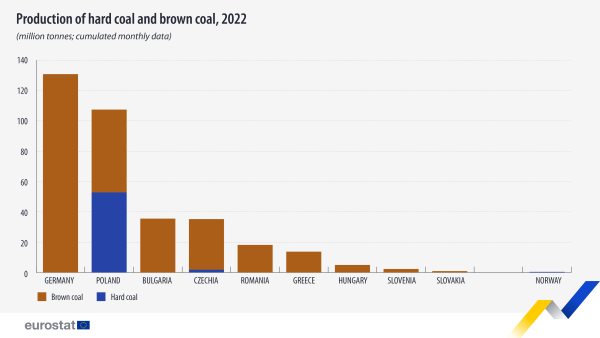Coal production and consumption statistics
Data extracted in June 2023.
Planned article update: June 2024.
Highlights
This article explains how consumption and supply of coal in the European Union (EU) and the European Free Trade Association (EFTA)[1] have evolved, highlighting the trends in production and consumption of the main types of solid fossil fuels: hard coal and brown coal. In addition the article gives some figures on the supply of coke oven coke.
Full article
Consumption and production of hard coal
As illustrated in Figure 1 inland consumption of hard coal in the EU decreased steadily in the 1990s. Starting in 1999 and for almost a decade, the yearly hard coal consumption stabilised at around 300 million tonnes. After a first sharp decline in 2008 and another in 2009, hard coal consumption stabilised around a new plateau of 250 million tonnes from 2010 onwards. Finally, in 2019, another strong decline in hard coal consumption started, amplified by the COVID-19 pandemic in 2020. The 2022 hard coal consumption of the EU is estimated to have reached 160 million tonnes, 28 % less than five years earlier.
Production of hard coal in the EU has decreased almost continuously from 1990, more consistently than consumption. In 2022, the EU production was 55 million tonnes, 80 % less than the 277 million tonnes of 1990. In 2022, 34 % of inland consumption could be covered by production in the EU, compared to 71 % in 1990. The gap between the two was mostly covered by imports (see Import dependency of hard coal). The 2022 figures are based on cumulated monthly data.
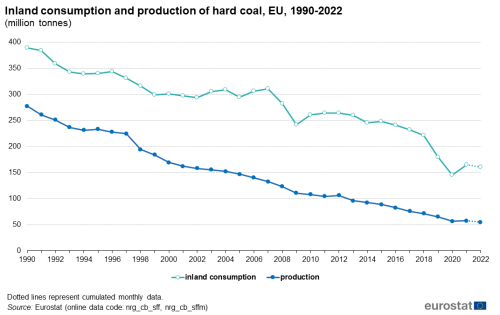
Source: Eurostat (nrg_cb_sff), (nrg_cb_sffm)
In 1990, 13 Member States of the current EU were producing hard coal. In 2022 there were only two left: Poland and Czechia. Poland produced 53 million tonnes of hard coal (97 % of the total EU production) and Czechia produced 1.8 million tonnes (3 %). Compared to 2012, which was the last peak in the EU hard coal production (106 million tonnes), in 2022 Poland decreased its production by 33 % and Czechia by 84 %.
Poland (38 %) and Germany (25 %) together accounted for almost two thirds of the total hard coal consumption of the EU in 2022, followed by Italy, the Netherlands, France, Spain and Czechia (each between 3 % and 7 %). Figure 2 presents the hard coal consumption of the EU from 2017 to 2022 by Member State. Apart from Malta, which stopped using hard coal in 1996, every other country in the EU reports consumption of hard coal ranging from a few thousand tonnes to several million tonnes.
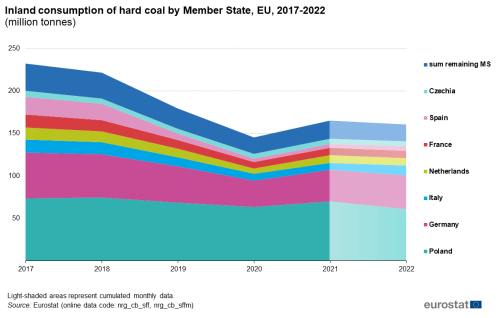
Source: Eurostat (nrg_cb_sff), (nrg_cb_sffm)
One country in EFTA still produces hard coal in 2021: Norway. Stable in the 1990s around 300 thousand tonnes, Norway’s hard coal production reached a peak of 4 million tonnes in 2007, before decreasing again to 121 thousand tonnes in 2021.
Consumption of hard coal by EFTA countries stayed stable around 1 million tonnes since 1990. In 2021, two EFTA countries, Norway and Iceland, reported a hard coal consumption of 1.1 million tonnes.
Import dependency of hard coal
Solid fossil fuels had a lower energy dependency rate of 37.5 % in 2021 compared to other fossil fuels, such as oil or natural gas (see Statistics Explained article on Energy statistics - an overview). However, this dependency rate accounts for all solid fossil fuels, including brown coal (with a high production and negligible trade) and many secondary products where the EU is a net exporter. Hard coal is the main type of coal with a noticeable import dependency, reaching 59.6 % in 2021.
Both the solid fossil fuels and hard coal import dependency curves had similar patterns (see Figure 3). Starting in 1990 at 18.7 % for solid fossil fuels and 29.6 % for hard coal, import dependency began to increase in the middle of the 1990s. By 2004, the rate of increase was slowing down, before reaching its highest point in 2018: 43.8 % for solid fossil fuels and 68.3 % for hard coal. The reason for this increase in imports dependency is that, although both production and consumption have decreased in the EU since 1990, consumption has decreased slower than production; the resulting gap was mostly filled by imports.
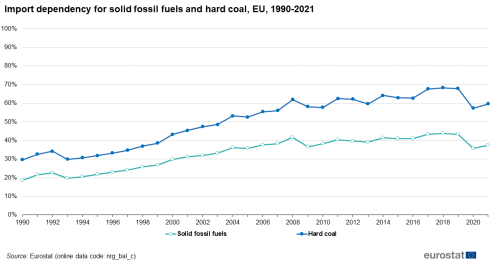
Source: Eurostat (nrg_bal_c)
In 2021, Russia supplied more than half (53.6 %) of the EU’s hard coal imports, followed by Australia (17.5 %) and the United States (15.7 %). Other important suppliers included Colombia, South Africa, Indonesia and Canada. In the 2010s, imports from most of these suppliers decreased or remained stable as consumption of hard coal in the EU decreased. The exception was Russia, for which EU countries reported an increase in imports reaching a high of 61 million tonnes in 2018, before decreasing until 2020 and increasing again in 2021 (see Figure 4).
Coal imports also depend on market prices and other factors, which can lead to changes in suppliers. Traditional hard coal suppliers to the EU such as Ukraine, Venezuela or Norway have seen their imports decrease in recent years; at the same time, new suppliers such as Kazakhstan, Mozambique or the United Kingdom have emerged.
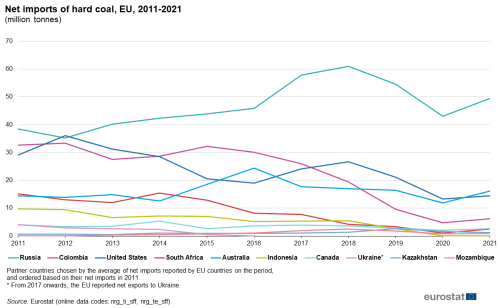
Source: Eurostat (nrg_ti_sff), (nrg_te_sff)
Consumption and production of brown coal
The 2022 consumption of brown coal in the EU is estimated at 294 million tonnes, 21 % less than in 2018. Figure 5 presents the trend since 1990. In the 1990s, the consumption decreased rapidly, broadly stagnating between 2000 and 2015 in a range of 400 to 450 million tonnes per year. From 2018 to 2020, consumption of brown coal decreased sharply, before increasing again. Despite the recent increase, the 2022 EU consumption of brown coal is still estimated to be slightly below the pre-pandemic one of 2019.
The brown coal production trend is very similar to its consumption trend; brown coal is mostly produced in the countries of the consumption, while imports and exports are negligible. The 2022 figures are based on cumulated monthly data.
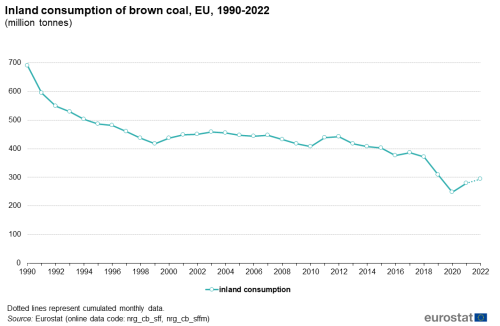
Source: Eurostat (nrg_cb_sff), (nrg_cb_sffm)
Germany represented 45 % of the total brown coal consumption of the EU in 2022, followed by Poland (19 %), Bulgaria (12 %), Czechia (11 %), Romania (6 %) and Greece (5 %). Figure 6 presents the brown coal consumption of the EU from 2017 to 2022 by Member State.
Brown coal is absent from the EFTA countries’ energy mix (production and consumption).
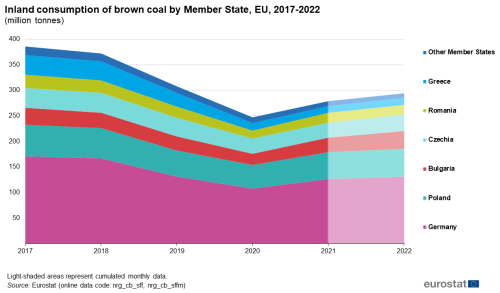
Source: Eurostat (nrg_cb_sff), (nrg_cb_sffm)
Deliveries of coal to power plants
A slight majority of hard coal (52 % in 2021) and a large majority of brown coal (92 % in 2021) is used for power production. In 2021, 86 million tonnes of hard coal were delivered to power plants in the EU producing electricity and heat. For brown coal, this amount was 256 million tonnes.
Figure 7 shows that from 2013 to 2020, hard coal deliveries for power production showed a declining trend, which accelerated in 2019 and 2020; in electricity and heat production, hard coal is replaced more and more by natural gas and renewable energy sources. Furthermore, a large part of hard coal is used in the industry sector, particularly in coke ovens (see Figure 9). Brown coal deliveries to power plants also show a declining trend since 2013. In 2021, deliveries of both hard coal and brown coal to power plants rose for the first time in almost a decade, although the figures are still lower than in 2019.
In EFTA countries, deliveries of hard coal to power plants hovered around 30 thousand tonnes between 1990 and 2021; they only represent a marginal use of hard coal (2 % in 2021) as EFTA countries use hard coal mainly in their industry sector.
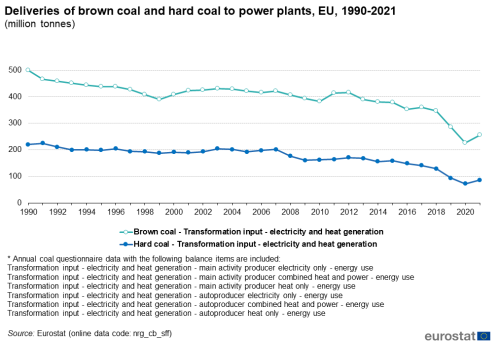
Source: Eurostat (nrg_cb_sff)
Deliveries of coal to coking plants and coke oven coke production
Hard coal (more specifically coking coal) is essential to produce coke oven coke for the steel and iron industry. In 2021, coking plants in the EU consumed 41 million tonnes of coking coal to produce 31 million tonnes of coke oven coke. Coking plant activity was stable until 2019, when it started to decline, before seeing a small rise in 2021 (see Figure 8).
No activity for coke ovens was recorded in EFTA countries.
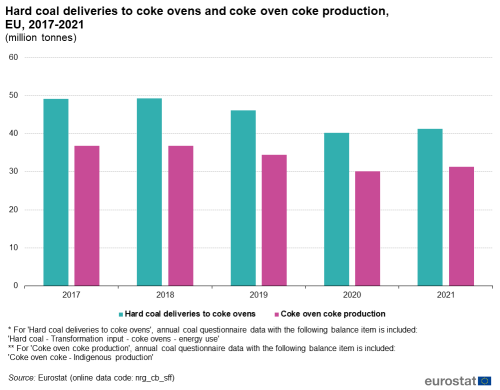
Source: Eurostat (nrg_cb_sff)
Source data for tables and graphs
Data sources
The reporting of coal statistics is based on Energy statistics Regulation (EC) No 1099/2008 on energy statistics. The production and consumption data of hard coal, brown coal and coke oven coke between 1990 and 2021 are based on annual statistics (Annex B of the Regulation). For the latest available 2022 data, cumulative monthly data was used (Annex C of the Regulation). These cumulative monthly data could be considered as provisional/estimates of annual statistics.
Methodological note
The methodologies and data used for the calculations presented in this article do not make it possible to identify the specific contribution of the 2020 COVID-19 pandemic compared to the existing trends from the data. Future data will allow Eurostat to ascertain whether the observed trends are maintained during and after the pandemic.
Direct access to
- Energy Statistics - main indicators (t_nrg_indic)
- Final energy consumption by product (ten00123)
- Energy statistics - quantities (nrg_quant)
- Energy statistics - quantities, annual data (nrg_quanta)
- Supply, transformation and consumption - commodity balances (nrg_cb)
- Supply, transformation and consumption of solid fossil fuels (nrg_cb_sff)
- Supply, transformation and consumption - commodity balances (nrg_cb)
- Energy statistics - quantities, annual data (nrg_quanta)
- Energy statistics - quantities (nrg_quant)
- Energy statistics - quantities, monthly data (nrg_quantm)
- Supply, transformation and consumption - commodity balances - monthly data (nrg_cb_m)
- Supply, transformation and consumption of solid fossil fuels - monthly data (nrg_cb_sffm)
- Supply, transformation and consumption - commodity balances - monthly data (nrg_cb_m)
- Energy statistics - quantities, monthly data (nrg_quantm)
- Energy statistics - quantities (nrg_quant)
- Energy statistics - quantities, annual data (nrg_quanta)
- Trade by partner country (nrg_t)
- Imports (nrg_ti)
- Imports of solid fossil fuels by partner countries (nrg_ti_sff)
- Imports (nrg_ti)
- Trade by partner country (nrg_t)
- Energy statistics - quantities, annual data (nrg_quanta)
- Energy statistics - quantities (nrg_quant)
- Energy statistics - quantities, annual data (nrg_quanta)
- Trade by partner country (nrg_t)
- Exports (nrg_te)
- Exports of solid fossil fuels by partner countries (nrg_te_sff)
- Exports (nrg_te)
- Trade by partner country (nrg_t)
- Energy statistics - quantities, annual data (nrg_quanta)
- Energy statistics - quantities (nrg_quant)
- Energy statistics - quantities, annual data (nrg_quanta)
- Energy balances(nrg_bal)
- Complete energy balances (nrg_bal_c)
- Energy balances(nrg_bal)
- Energy statistics - quantities, annual data (nrg_quanta)
Visualisations
- Supply, transformation and consumption - commodity balances (annual) - ESMS metadata file (nrg_cb_esms)
- Energy statistics - quantities - ESMS metadata file (nrg_quant_esms)
- Energy statistics - supply, transformation, consumption (monthly) - ESMS metadata file (nrg_10m_esms)
- Trade by partner country - ESMS metadata file (nrg_t_esms)
- Regulation (EC) No 1099/2008 of 22 October 2008 on energy statistics
- Summaries of EU legislation: Common system for the production of energy statistics
Notes
- ↑ Data for the European Free Trade Association (EFTA) does not include Switzerland, as there is no agreement in place regarding the dissemination by Eurostat of Swiss energy statistics.
